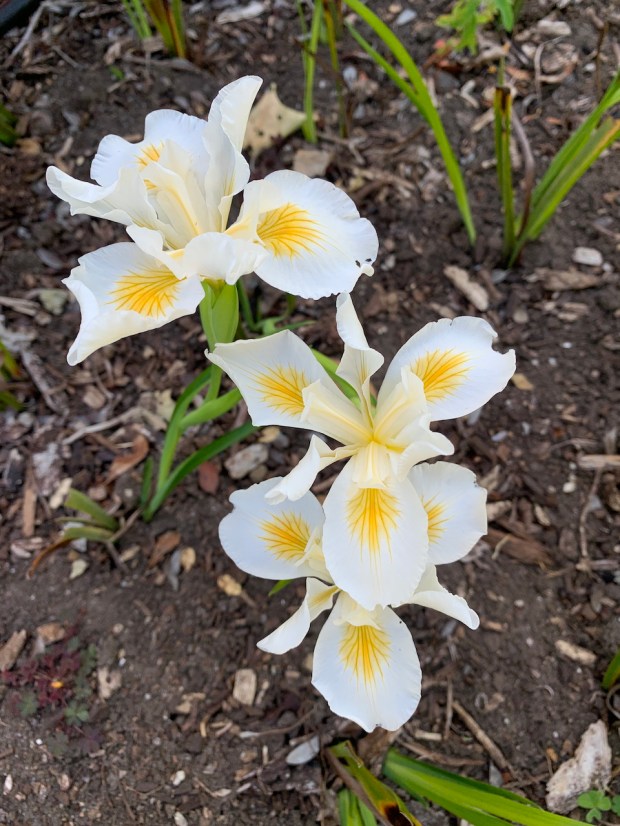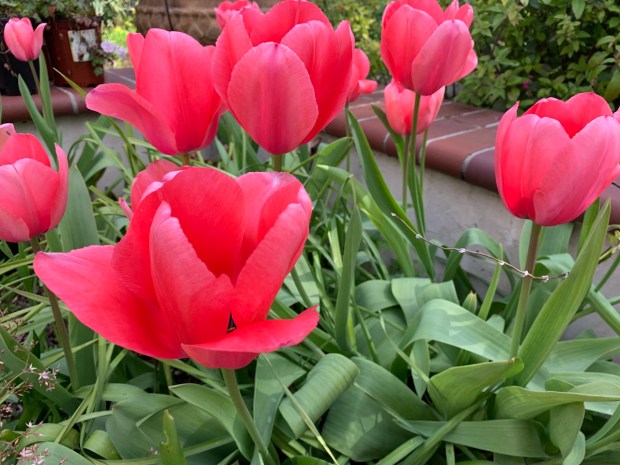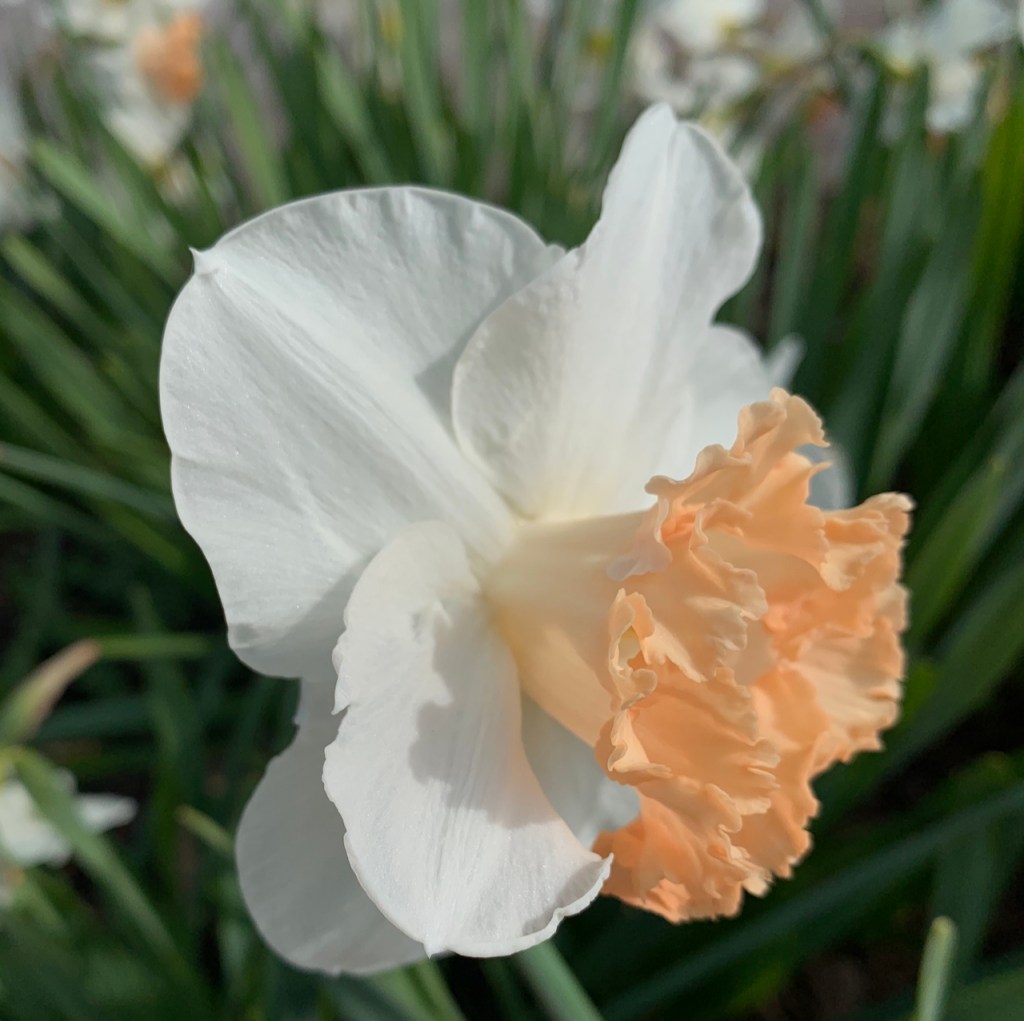Wild freesia (Freesia alba). This South African plant grows from a conical corm, produces a branched stem up to 16 inches tall, and, in the spring, produces an inflorescence with several fragrant flowers with usually white tepals marked with yellow and purple. It is a member of the iris family (Iridaceae). The species became available for gardens in 1878. After first regarded as a subspecies of F. leichtlinii, it is now considered to be the same species. (Courtesy Tom Karwin)

Garden hyacinth (Hyacinthus orientalis). A member of the asparagus plant family (Asparagales), this plant is native to western Asia. It was introduced to Europe in the 16th century and is now widely cultivated due to its raceme of fragrant flowers blooming in the early spring. It grows and propagates easily. (Courtesy Tom Karwin)

Daffodil hybrid (Narcissus ‘Mon Cheri’). Nothing says spring like Narcissus ‘Mon Cheri,’ registered in 1983. It has large flowers and exceptional, frilly, apricot-pink cups set off by white petals. The French cultivar name, mon cheri, means “my dear” and is what a woman would say to a man. Ma cherie is a term a man would use to address a woman. (Courtesy Tom Karwin)

Pacific coast hybrid iris (Iris douglasiana ‘Canyon Snow’). In 1975, the Santa Barbara Botanic Garden introduced this slowly spreading rhizomatous perennial. It develops clumps of sword-shaped green leaves and produces orchid-like flowers, with bright yellow central markings on each petal. It has earned the American Iris Society’s prestigious Mitchell Award. (Courtesy Tom Karwin)

Triumph tulip hybrid (Tulipa ‘Peer Gynt’). A member of the triumph group, this tulip grows 14 to 16 inches in mid-spring. Bulbs of this plant were acquired during a visit to the Netherlands, Keukenhof, in the province of South Holland. This tulip grows each year in my garden without the winter chill that most tulips require. It has been a favored spring bulb for centuries and is difficult to find in the current market. (Courtesy Tom Karwin)
Show Caption
1 of 5
Wild freesia (Freesia alba). This South African plant grows from a conical corm, produces a branched stem up to 16 inches tall, and, in the spring, produces an inflorescence with several fragrant flowers with usually white tepals marked with yellow and purple. It is a member of the iris family (Iridaceae). The species became available for gardens in 1878. After first regarded as a subspecies of F. leichtlinii, it is now considered to be the same species. (Courtesy Tom Karwin)
Expand
As we enter the fall season, gardeners consider planting selected bulbs for enjoyment as they bloom in the spring.
This column opens with a brief overview of bulbs in the garden and focuses on fall-planted, spring-blooming bulbs.
The botanical term for the category of these plants is geophyte, which ScienceDirect defines as “plants with tuberous subterranean organs, such as leaf bases, roots or stems, that store food and enable rapid growth when favorable climatic conditions return.”
Geophytes include true bulbs as well as corms, tubers, rhizomes and tuberous roots. Some gardeners refer to all these types collectively as “bulbs.”
True bulbs have layered bulb scales, a basal plate and a protective tunic. Most are planted in a hole three times as deep as the bulb’s diameter. Examples include freesias and tulips. There are exceptions: a friend recently gave me several large bulbs of forest lilies (Veltheimia bracteata), natives of South Africa. Quick research of planting recommendations indicates gardeners should face the pointed tips upwards and bury the bulbs about 1 inch deep with the neck exposed.
Corms are solid organs with swollen stem tissue. Plant them 2 to 4 inches deep, depending on corm size. Examples include Crocus, Gladiolus and Fritillaria.
Rhizomes have horizontal stems underground or at the soil’s surface. Plant rhizomes at or just below the soil’s surface, with growing points exposed or barely covered. Examples: bearded iris and Pacific coast iris. Exceptions: Plant Canna rhizomes 4 to 6 inches deep for stability.
Tuberous roots have swollen roots or underground stems and lack tunics. Plant these 2 to 6 inches deep, depending on the species. Examples: dahlias, tuberous begonias and Pacific bleeding heart (Dicentra formosa).
Caudiciform and succulent geophytes have a swollen stem base (crown) or caudex. Plant the caudex or crown at or above soil level or partially exposed for ornamental effect. Do not bury. Examples: dudleya farinosa, Dioscorea, Adenium.
To dig into the distinctions between these kinds of geophytes, look below for “Advance for your gardening knowledge.”
Blooming periods
Spring-blooming bulbs include these genera: Allium, Greek windflower (Anemone blanda), Camassia, crocus, early narcissus, winter aconite (Eranthis hyemalis), Fritillaria, Galanthus, hyacinthus orientalis, iris × hollandica, iris reticulata, spring snowflake (Leucojum vernum), muscari, wood squill (Scilla siberica) and Tulipa. Plant them in September or October, or as late as December, allowing time for winter chill.
Summer-blooming bulbs can be planted in early spring (after the last frost). These include callas, Chinese windflower (Eriocapitella hupehensis), crocosmias, dahlias, gladioli and tuberous begonias.
In comparison, plant fall-blooming bulbs in late summer. Examples include autumn crocus (Colchicum autumnale), winter daffodil (Sternbergia), guernsey lily (Nerine bowdenii), saffron crocus (Crocus sativus) and snowdrops (Galanthus reginae-olgae).
Today’s image gallery
These are a few examples of spring-blooming geophytes in my garden.
Planting spring bloomers
Before planting, some spring bloomers benefit from being soaked for 30 minutes or more, or being chilled for 10 hours or more. In the Monterey Bay area’s temperate climate, winter months will give most bulbs sufficient chilling. As an exception, tulips require chilling for 12 hours or more to bloom effectively.
Most geophytes grow best under full sun, but there are exceptions. For example, the forest lily mentioned above prefers partial shade. Always look up the cultivation requirements for any unfamiliar plant, searching online by the plant’s botanical name.
Install true bulbs with “the pointed end up and the roots down.” If this orientation is unclear, install the bulb sideways and let nature decide.
See the previous summary of planting depths for different kinds of geophytes.
For attractive landscaping, arrange the bulbs in groups of various sizes, either in the ground or in containers.
Water newly planted bulbs to settle the soil and cover the bed with mulch to retain moisture and discourage weeds.
Advance your gardening knowledge
For more about geophytes, visit ucanr.edu and search for “bulbs, corms, rhizomes and tubers.” This University of California website includes a series of articles of interest and value.
Longfield Gardens’ website has a guide to the bloom times of several flower bulbs, ranging from spring to fall. Visit longfield-gardens.com and search for “bloom time planning guide.”
Interested gardeners can explore mail-order sources of fall-planted/spring-blooming bulbs. Examples include Brent and Becky’s Bulbs (visit brentandbeckysbulbs.com and search for “fall planted bulbs”) and Eden Brothers (visit edenbrothers.com and search for “spring flower bulbs”).
Mark your calendar
Monterey Bay Area Cactus and Succulent Society has announced its fall show and sale, 9 a.m. to 5 p.m. Sept. 13, and 9 a.m. to 3 p.m. Sept. 14. The society will locate the event at the Portuguese Community Hall, 124 Atkinson Lane, Watsonville. The event provides free admission and ample parking.
Gardeners interested in adding cactuses, succulents or both to their gardens will choose from a 10,000-square-foot display of plants offered by 18 growers from the Monterey Bay area, the Central Coast and Northern California. Several pottery vendors will also offer unique hand-made containers designed for cacti and succulents.
The event includes hundreds of exceptional plants selected and grown by members of the society, providing an extraordinary opportunity for gardeners to observe the many different forms of cacti and succulents and appreciate the quality of well-grown specimens.
For more about this event, visit mbsucculent.org and click on “2025 Show and Sale.”
This week in the garden
Consider including spring-blooming bulbs in your garden. Look for bulbs offered in local garden centers or by online sources listed above. Some online sources offer large quantities of bulbs for large-scale plantings. Gardeners with ample space for a prominent display can install large beds of bulbs easily and quickly.
Enjoy your garden!
Tom Karwin is a past president of Friends of the UC Santa Cruz Arboretum and the Monterey Bay Iris Society, a past president and lifetime member of the Monterey Bay Area Cactus and Succulent Society, a Lifetime UC Master Gardener (certified 1999-2009), past board member of the Santa Cruz Hostel Society and active with the Pacific Horticultural Society and other garden-related societies. To view photos from his garden, visit facebook.com/ongardeningcom-566511763375123. To review the archive of recent On Gardening columns, visit santacruzsentinel.com and search “Karwin.” Go to ongardening.com to review columns from 2012-2020 (and soon) from 2025. Send comments or questions by email to gardening@karwin.com.


Comments are closed.